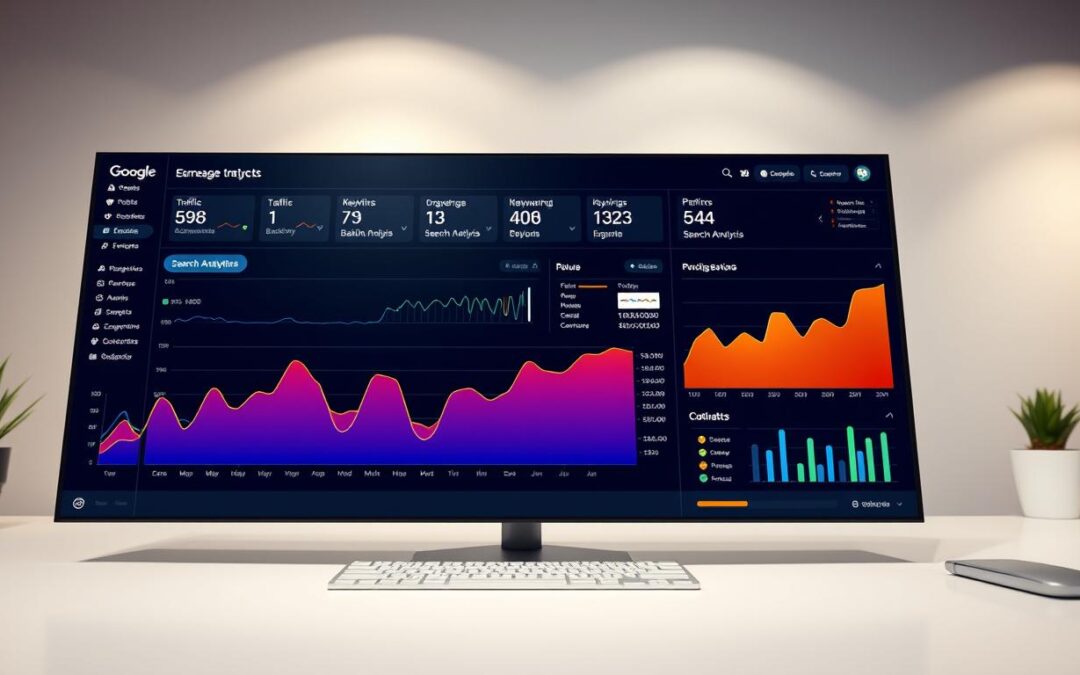Are you finding it hard to understand your website’s traffic and user behavior? Do you wish you had a clearer picture of what’s working and what’s not? We get how tough it is to navigate digital marketing. That’s why Google Analytics reporting tools are here to help.
These data visualization software solutions unlock valuable insights into your website’s performance. They help you make informed decisions to improve your online presence. By using these SEO analytics platforms, you can better understand your audience and track your goals.
With Google Analytics 4 (GA4) on the way, it’s key to stay updated. Explore Google Analytics reporting tools and see how they can change your digital marketing game. For more on the tools available, check out this article on 8 free and paid Google Analytics reporting.
Key Takeaways
- Unlock valuable insights into your website’s traffic and user behavior
- Make data-driven decisions to optimize your online presence
- Gain a deeper understanding of your audience and track your goals
- Measure the success of your campaigns with ease
- Stay ahead of the curve with the transition to Google Analytics 4 (GA4)
The Power of Data-Driven Decision Making
Data-driven decision making is key to successful digital marketing. We use digital marketing reporting tools to get insights. These insights help us understand our audience better and improve our campaigns.
Why Analytics Matter in Today’s Digital Landscape
In today’s world, analytics are very important. They help us understand how users behave and track our marketing success. Tools like Google Analytics let us see website traffic and make smart decisions for growth.
How Insights Drive Business Growth
Insights from website traffic analysis tools help us make our marketing better. They improve user experience and increase conversions. By using data-driven decision-making tools, we can focus our efforts and reach our goals.
Google Analytics Reporting Tools: An Overview
In today’s digital world, Google Analytics reporting tools are key for making smart decisions. They help businesses understand their online presence. These tools give deep insights into how websites perform and how users behave.
Core Features of Google Analytics4
Google Analytics4 brings new features like tracking across different devices. It also has better measurement tools. With Google Analytics4, businesses can see how users move across devices and platforms. This gives a clear picture of customer paths.
Universal Analytics vs. Google Analytics4
The move from Universal Analytics to Google Analytics4 is a big change. Google Analytics4 has a more flexible data model. This means businesses can track events and user actions better.
Free vs. Premium Analytics Options
Businesses have to choose between the free and premium versions of Google Analytics. The free version has great analytics tools. But, the premium version has more features and can handle more data. It’s best for big companies with complex needs.
Essential Reports in Google Analytics
To get the most out of Google Analytics, it’s key to know its main reporting features. These reports give a full view of your website’s performance. They help you make smart choices for your digital marketing.
Acquisition Reports
Acquisition reports show where your website traffic comes from. Traffic Source Analysis tells you which channels bring visitors, like organic search or social media.
Traffic Source Analysis
By looking at traffic sources, you can see which channels work best. Then, you can focus your efforts there.
Campaign Performance Tracking
Campaign performance tracking lets you see how well your marketing campaigns do. This helps you make them better for the future.
Behavior Reports
Behavior reports give insights into how users interact with your site. Page Performance Metrics show which content is popular and where you can improve.
Page Performance Metrics
Looking at page performance metrics, like bounce rate, helps you make your content better.
Site Speed Analysis
Site speed analysis is important. Slow pages can hurt user experience and your search rankings.
Conversion Reports
Conversion reports are key for seeing if your website meets your business goals. Goal Completion Tracking and E-commerce Performance analysis show what’s working and what’s not.
Goal Completion Tracking
Tracking goal completions shows if your website is driving conversions, like form submissions.
E-commerce Performance
E-commerce performance analysis looks at sales, revenue, and product performance. It helps you make decisions to increase online sales.
Creating Custom Reports for Deeper Insights
To get the most out of Google Analytics, businesses need to make custom reports. These reports help track important KPIs and metrics for success online.
Defining Your Key Performance Indicators
Finding the right KPIs is key for good custom reports. Start by knowing your business goals. Then, pick metrics that match these goals. This way, you can track your progress and make data-driven decisions for growth.
Building Custom Dimensions and Metrics
Google Analytics lets you create custom dimensions and metrics. This is great for tracking unique data important to your business. Use data visualization software to show this data clearly and helpfully.
Automated Reporting Schedules
Automated reporting schedules send insights to stakeholders on time. This is great for businesses that need regular data analysis. An online performance tracking tool helps you keep up with your data and make timely changes.

By using these strategies, businesses can fully use Google Analytics for growth. With the right tools, your data can guide your business decisions.
Advanced Analytics Techniques
Advanced analytics in Google Analytics can change how we do digital marketing. These tools help us understand our audience better. This way, we can make our marketing efforts more effective.
Audience Segmentation Strategies
Audience segmentation lets us split our audience into groups. We do this based on certain criteria. This makes our marketing more focused and improves how we connect with customers.
We can group users by demographics, behavior, or how they found us.
Attribution Modeling
Attribution modeling shows us how marketing channels lead to sales. It helps us spend our marketing budget wisely. For more on this, check out Google Analytics Developers.
Funnel Visualization
Funnel visualization is great for seeing how users move towards a sale. It shows where people drop off. This helps us make the path to sale better.
Cohort Analysis
Cohort analysis lets us follow groups of users over time. It shows how different groups use our site and how their actions change.
| Technique | Description | Benefit |
|---|---|---|
| Audience Segmentation | Divide audience into distinct groups | Targeted marketing |
| Attribution Modeling | Understand channel contributions to conversions | Effective budget allocation |
| Funnel Visualization | Analyze steps to conversion | Optimized user journey |
| Cohort Analysis | Track user groups over time | Understanding user behavior |
Learning these advanced analytics can really boost our digital marketing. It helps us make smart choices based on data. This leads to business growth.
Integrating Google Analytics with Your Marketing Stack
Connecting Google Analytics to your marketing stack gives you deeper insights. It helps you understand your digital marketing better. This way, you can make decisions based on data, helping your business grow.
Google Ads and Search Console Integration
Linking Google Analytics with Google Ads and Search Console boosts your campaign tracking. It lets you see how well your ads are doing. Google says, “Linking Google Ads and Search Console to Google Analytics gives a full view of your online presence.”
CRM and Email Marketing Connections
Connecting your CRM and email marketing to Google Analytics gives a complete customer view. It tracks your customers from first contact to sale. Enhanced customer insights mean better marketing campaigns.
Third-Party Data Visualization Tools
Using third-party data visualization software boosts your analytics. Tools like Tableau or Power BI make complex data easy to understand. This leads to more informed decisions. As digital marketing needs grow, these tools become more valuable.

By linking Google Analytics with your marketing stack, you unlock its full power. This approach to digital marketing analytics helps businesses improve their strategies. It leads to better overall performance.
Overcoming Common Analytics Challenges
The journey to use online performance tracking tools well is full of hurdles. Businesses face many obstacles when they rely on data-driven decision-making tools. These challenges can slow them down.
Data Sampling Issues
Data sampling problems are a big challenge. Google Analytics might sample data to speed up report processing. But this can make insights less accurate. To solve this, use more detailed reporting options or change your date range to process less data.
Tracking Implementation Problems
Wrong tracking code setup can mess up data collection. Make sure your website analytics software is set up right. Regular checks can spot and fix tracking problems early on.
| Challenge | Solution |
|---|---|
| Data Sampling | Use granular reporting or adjust date ranges |
| Tracking Issues | Conduct regular audits and ensure correct code implementation |
| Privacy Compliance | Stay updated on regulations like GDPR and CCPA |
Privacy Compliance (GDPR, CCPA)
Keeping up with privacy laws is key. Knowing about GDPR and CCPA helps avoid fines and keeps users trusting you.
Data Quality Assurance
Checking your data regularly for errors and using data validation can really improve its quality. This way, you can make better decisions with reliable data.
Conclusion: Transforming Data into Action
Google Analytics reporting tools help businesses unlock their data’s full power. This leads to growth and better online presence. We’ve looked at Google Analytics’ key features and how to use them.
From making custom reports to advanced analytics, data visualization software is key. It helps businesses understand their audience and behavior better.
The success secret is turning data into useful insights. This way, businesses can improve their marketing, user experience, and conversions. We urge businesses to actively use Google Analytics to guide their decisions.
With the right tools, businesses can simplify complex data. This leads to clearer success paths. Google Analytics empowers companies to make informed decisions, grow, and reach their goals.

